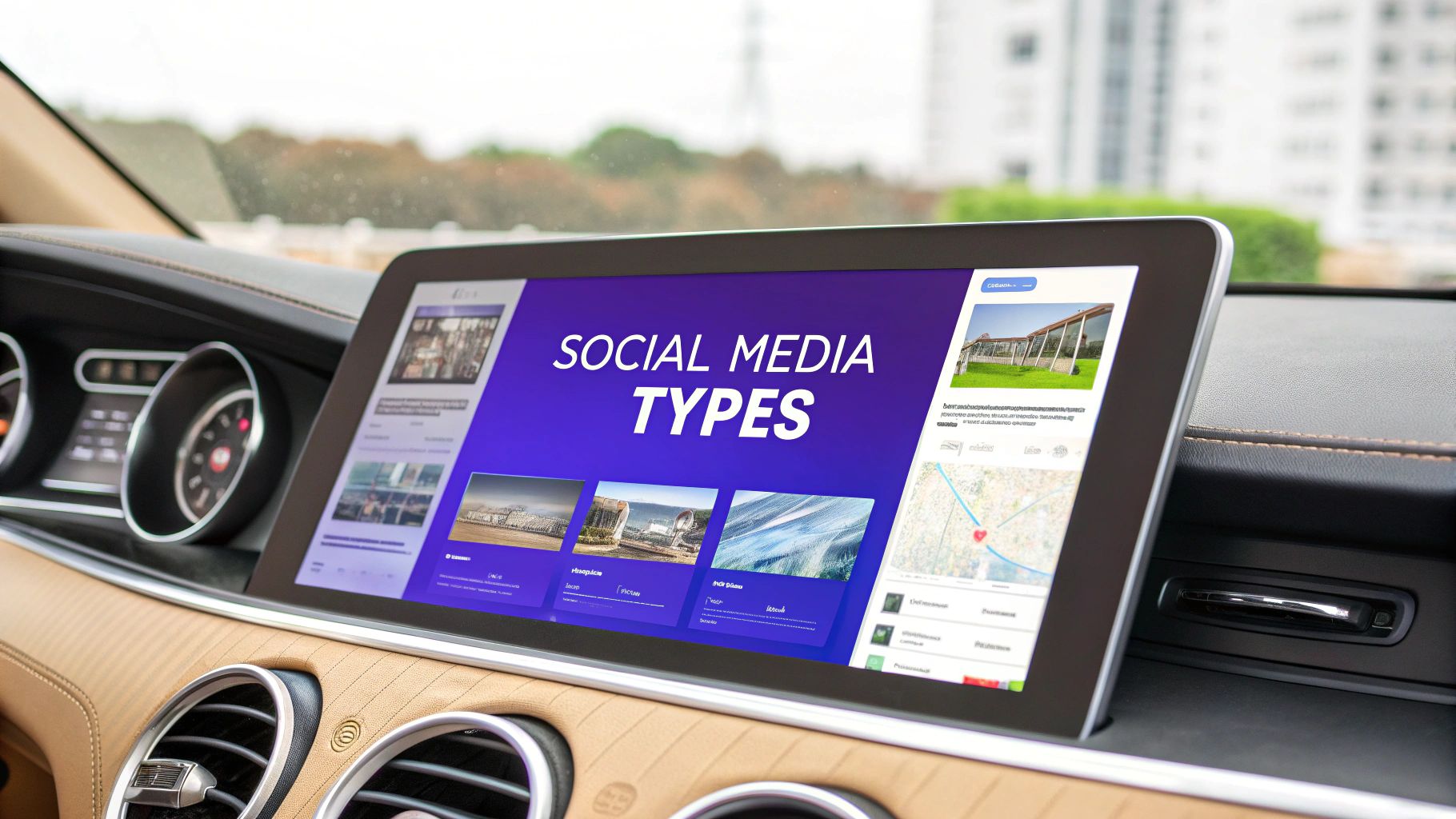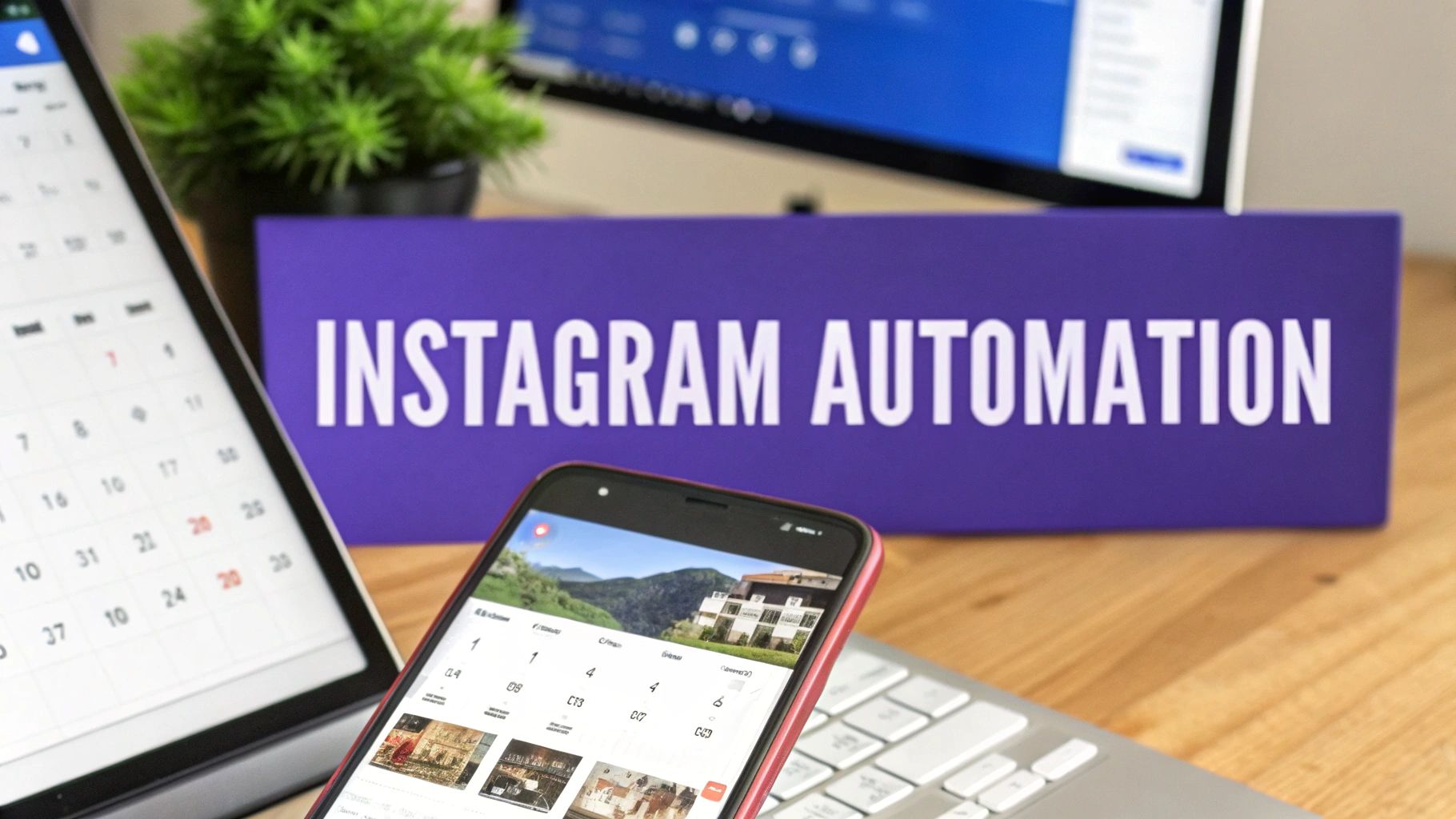The modern social media environment demands more than just consistent posting. To capture attention and drive tangible results, marketers need a diverse arsenal of content that engages, educates, and entertains. Success isn't just about variety; it's about strategically deploying the right format, on the right platform, for the right audience. Mastering the different types of social media content is fundamental to transforming a passive audience into an active community. This strategic approach forms the bedrock of any successful digital campaign.
Before you can effectively deploy these content types, you must have a solid framework in place. For a deeper dive into establishing this foundation, refer to this comprehensive guide to content planning for social media. A well-defined plan ensures every piece of content you create serves a specific purpose, contributing directly to your overarching goals.
This guide moves beyond theory to provide a practical breakdown of the 10 most effective content formats that deliver results today. We will explore everything from authentic User-Generated Content (UGC) and immersive Behind-the-Scenes videos to interactive polls and data-rich infographics. For each type, you'll find actionable insights, platform-specific best practices, and real-world examples to elevate your strategy. Prepare to move beyond simple broadcasting and start building a dynamic content ecosystem that fosters loyalty, drives conversions, and achieves your marketing objectives. Let's dive into the formats that will define your brand's success.
1. User-Generated Content (UGC)
User-Generated Content (UGC) stands out among the different types of social media content as it’s not created by the brand, but by its audience. It encompasses any content format, from images and videos to reviews and testimonials, voluntarily produced by unpaid fans or customers. This powerful, organic content leverages social proof to build brand trust and authenticity in a way that polished, branded content often cannot.
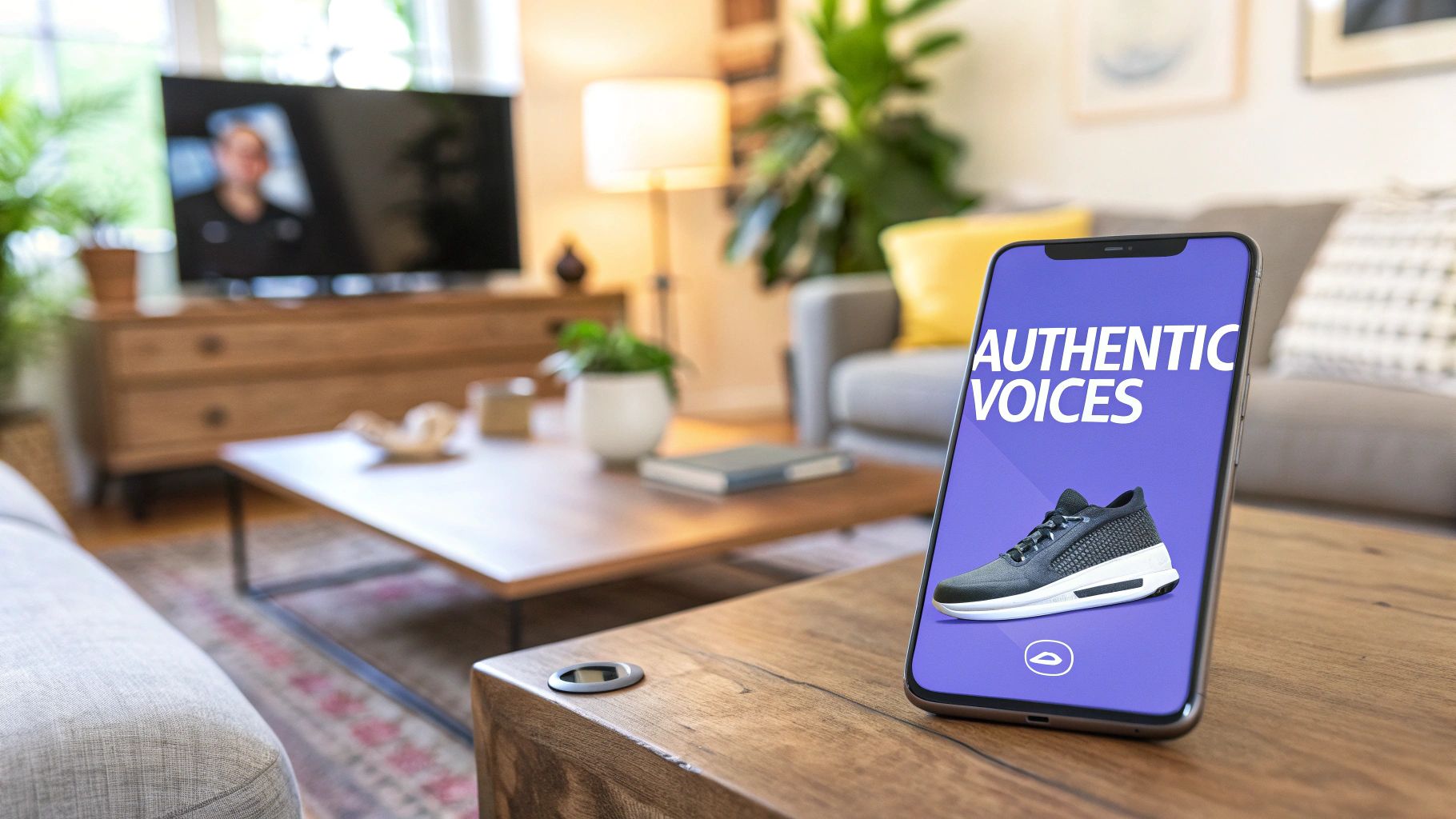
This approach transforms customers into a community of brand advocates. Consider GoPro, a brand that built its marketing foundation by showcasing thrilling adventure videos shot by its actual users. Similarly, Starbucks’ annual #RedCupContest masterfully encourages customers to become content creators, flooding social media with festive photos and fostering a powerful sense of seasonal community. These examples highlight how UGC can generate a massive volume of authentic content while strengthening customer loyalty.
When and Why to Use UGC
UGC is most effective when your goal is to build authenticity, increase engagement, and foster a strong community. It acts as a powerful form of word-of-mouth marketing, with studies showing that consumers find UGC 9.8x more impactful than influencer content when making purchasing decisions. Use it to supplement your content calendar, showcase real-world product use, and provide social proof that resonates deeply with potential customers.
Actionable Tips for Implementation
To effectively integrate UGC into your social media strategy, follow these best practices:
- Create Branded Hashtags: Develop a simple, memorable hashtag to encourage submissions and easily track content. Make it a central part of your campaign, like Coca-Cola's #ShareACoke.
- Always Ask for Permission: Before reposting any user's content, obtain their explicit permission. This not only respects their ownership but also builds goodwill.
- Offer Incentives: Drive participation by running contests, offering discounts, or featuring top submissions on your profile. A simple shout-out can be a powerful motivator.
- Engage with Contributors: Acknowledge every submission you can. A like, comment, or share shows your appreciation and encourages future participation from the entire community.
2. Behind-the-Scenes Content
Behind-the-Scenes (BTS) content is one of the most effective types of social media content for humanizing a brand. It pulls back the curtain, offering audiences an exclusive, unpolished look at the people, processes, and culture that power the business. By revealing the inner workings, from product creation to daily office life, BTS content builds a powerful sense of transparency and relatability that fosters deep audience connections.
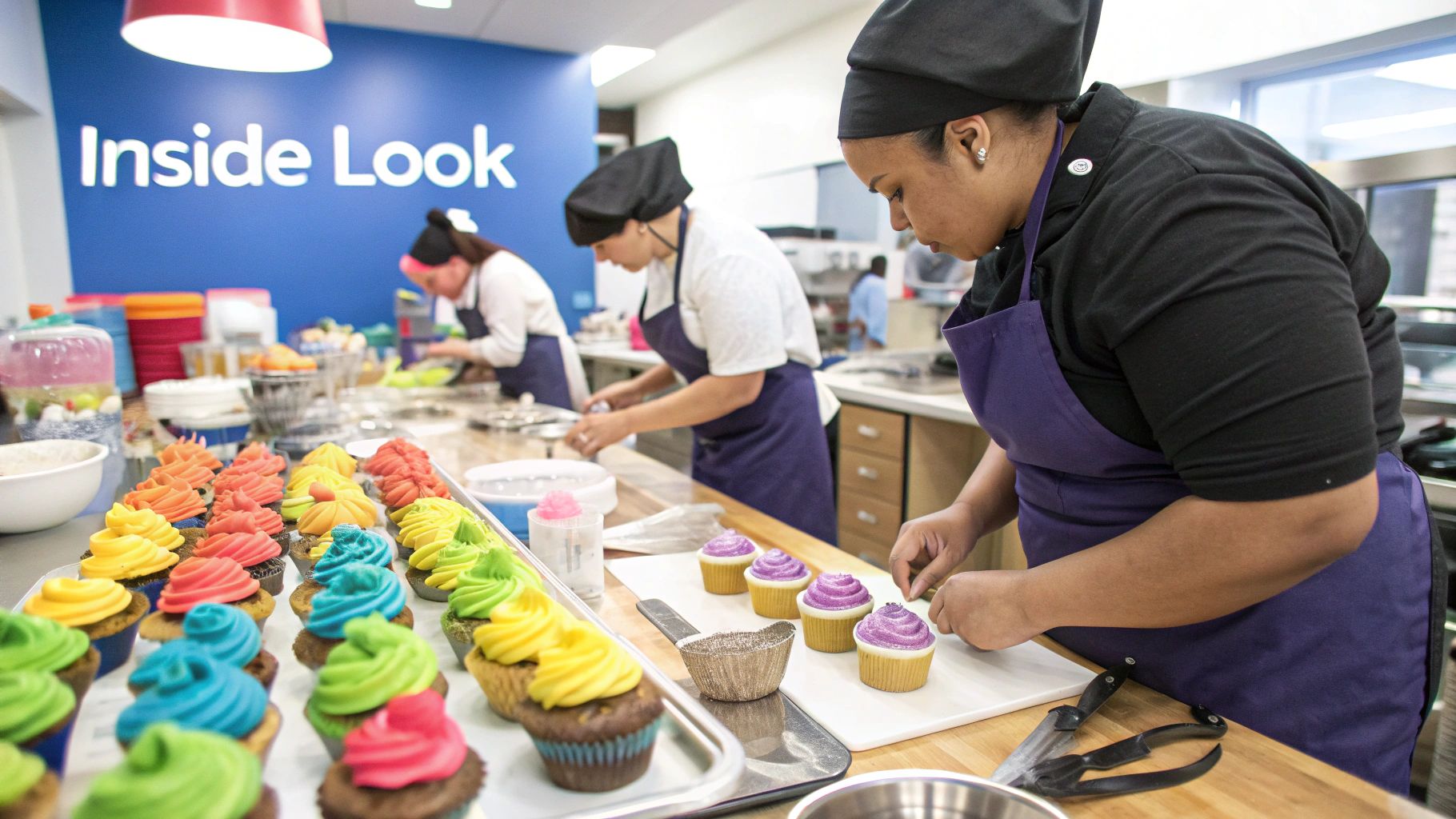
This approach transforms a faceless corporation into a team of passionate individuals. For example, Tesla frequently shares videos of its manufacturing and design process, giving customers a glimpse into the innovation behind their vehicles. Similarly, many restaurants showcase their kitchen operations and food preparation, building trust and whetting appetites simultaneously. These glimpses into the "how" behind the "what" make a brand feel more authentic and accessible, strengthening customer trust and loyalty.
When and Why to Use Behind-the-Scenes Content
Behind-the-Scenes content is ideal when your primary goal is to build trust, showcase your brand’s personality, and create a stronger emotional connection with your audience. It demystifies your business and highlights the hard work and care that go into your products or services. Use it to introduce your team, explain a complex process in a simple way, or share the journey of a new product from concept to launch. This transparency is highly valued by modern consumers, who increasingly seek authentic relationships with the brands they support.
Actionable Tips for Implementation
To successfully incorporate BTS content into your social media strategy, consider these practical tips:
- Spotlight Your Team: Introduce employees and share their stories. Putting faces to your brand name adds immense personality and makes your company more relatable.
- Show the Process, Not Just the Product: Document how your product is made, a service is delivered, or how your team brainstorms new ideas. This adds value and appreciation.
- Embrace Imperfection: Don't over-polish everything. Raw, unscripted moments often feel more genuine and resonate better. Use Instagram Stories or TikTok for casual, in-the-moment updates.
- Document Key Moments: Capture the excitement around special events, product launches, or company milestones. This makes your audience feel like they are part of your brand’s journey.
3. Educational Content
Educational content is a cornerstone among the various types of social media content, designed to inform, teach, and provide tangible value to an audience's knowledge base. This approach positions brands as credible thought leaders and trusted experts in their field. It delivers practical value that audiences actively seek out, ranging from quick-fix tips and how-to guides to comprehensive tutorials and deep industry insights.

This strategy helps build a loyal following by empowering users rather than just selling to them. For instance, HubSpot excels at this with its extensive library of marketing and sales blogs and videos that educate professionals. Similarly, Canva provides countless design tutorials, while Adobe offers software guides that help creatives master their tools. These examples demonstrate how sharing expertise builds trust and keeps audiences returning for more valuable information.
When and Why to Use Educational Content
Educational content is most powerful when your objective is to establish authority, build long-term trust, and nurture leads. By helping your audience solve their problems, you create a positive brand association that transcends a simple transactional relationship. This is crucial for complex products or services where a customer's journey involves research and learning. If your focus is on educational content, understanding how to create engaging educational videos can significantly boost your impact and audience retention.
Actionable Tips for Implementation
To successfully leverage educational content in your social media content strategy, consider these best practices:
- Focus on Audience Problems: Identify the specific pain points and questions your target audience has. Create content that directly addresses these challenges and offers clear, practical solutions.
- Break Down Complex Topics: Make sophisticated subjects accessible by breaking them into smaller, digestible pieces. Use carousels, short videos, or step-by-step guides to simplify learning.
- Create Content Pillars: Develop a series around a core topic. This encourages repeat visits as your audience anticipates the next installment, building a consistent viewership.
- Optimize for Search and Discovery: Use relevant keywords and phrases in your captions, descriptions, and titles to help users find your valuable content when they are actively searching for answers.
4. Interactive Content
Interactive content is a powerful category among the different types of social media content that requires active participation from the audience, shifting them from passive viewers to engaged contributors. This format includes polls, quizzes, Q&A sessions, live streams, and other elements that prompt a response. By creating a two-way dialogue, interactive content fosters a deeper connection and sense of community while simultaneously providing brands with valuable, real-time audience insights.
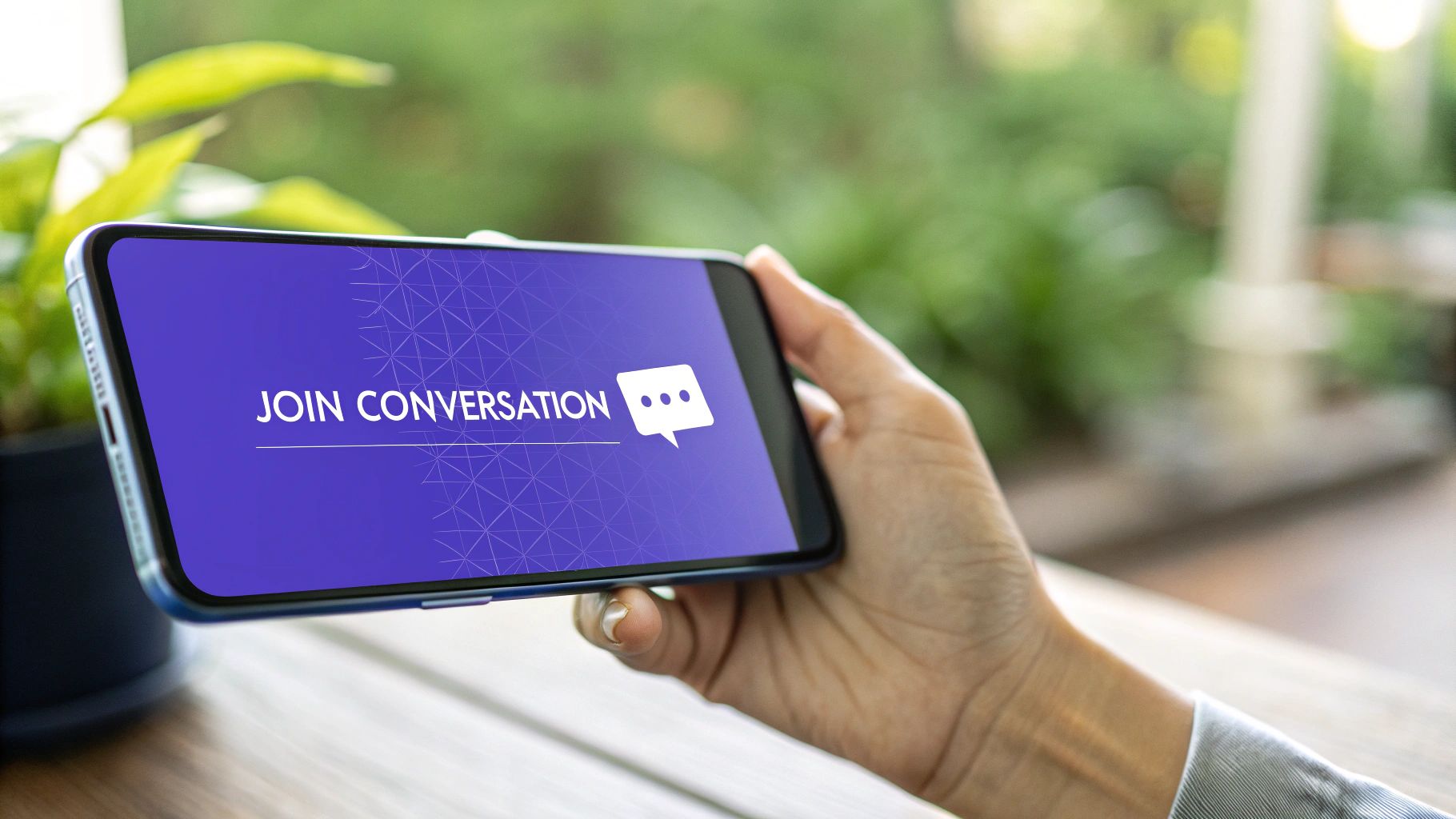
This method transforms content from a monologue into a conversation. BuzzFeed famously built its media empire on the back of viral personality quizzes, while Instagram Stories revolutionized daily engagement with features like polls, sliders, and question stickers. Similarly, Spotify's annual 'Wrapped' campaign is a masterclass in personalized interactive content, turning individual user data into a shareable social event. These examples show how interaction can dramatically boost engagement, reach, and data collection.
When and Why to Use Interactive Content
Interactive content is ideal when your primary goals are to boost engagement rates, gather audience feedback, and humanize your brand. It excels at stopping the scroll and encouraging users to spend more time with your content. Use interactive formats to test new product ideas, understand customer preferences, or simply spark fun conversations that strengthen your community bond and increase your content's visibility through platform algorithms that favor high engagement.
Actionable Tips for Implementation
To effectively leverage interactive content in your social media marketing, consider these strategies:
- Utilize Native Platform Features: Use built-in tools like Instagram and X (formerly Twitter) polls or question stickers in Stories for quick, low-effort audience feedback.
- Host Regular Live Sessions: Schedule consistent live Q&As or behind-the-scenes streams. This builds anticipation and creates a reliable space for direct community interaction.
- Create Value-Driven Quizzes: Design quizzes that either entertain (e.g., "What's Your Skincare Personality?") or educate, providing users with a valuable outcome that also gives you market insights.
- Gamify the Experience: Drive participation through contests, challenges, or leaderboards. Gamification introduces a competitive element that can significantly increase involvement and shareability.
5. Storytelling Content
Storytelling content leverages narrative techniques to create a powerful emotional connection with an audience. Instead of directly selling a product or service, this approach weaves a compelling story that shares experiences, values, and messages. Among the various types of social media content, storytelling is uniquely effective at making a brand more human, memorable, and relatable by tapping into fundamental human psychology.
This format transforms passive viewers into an engaged audience invested in a narrative. Consider the immense success of Humans of New York, which built a global community by sharing the deeply personal stories of strangers. Similarly, Patagonia excels by telling stories not just about its products, but about environmental activism and the adventures of its community, reinforcing its core mission. These examples show how a well-told story can resonate far more deeply than a simple advertisement.
When and Why to Use Storytelling Content
Storytelling is most powerful when your goal is to build brand affinity, communicate complex values, and differentiate yourself in a crowded market. It's the ideal choice for humanizing your brand and creating content that people remember and share. Use storytelling to share your brand's origin, highlight customer successes, or take a stand on issues that matter to your audience. This method moves beyond transactional interactions to foster genuine, long-term loyalty.
Actionable Tips for Implementation
To effectively integrate storytelling into your social media strategy, follow these best practices:
- Start with a Relatable Character: Center your narrative around a person, whether a customer, founder, or employee. Authentic situations and relatable struggles create an immediate connection.
- Introduce Conflict or a Challenge: A story needs tension to be compelling. Showcase a problem, an obstacle, or a journey of perseverance to keep your audience invested from beginning to end. Nike's athlete stories master this by focusing on the struggle before the triumph.
- Connect to Broader Brand Values: Ensure every story, big or small, reinforces your brand's core mission or values. A story from Airbnb isn't just about a nice trip; it's about belonging anywhere.
- Use Strong Visuals: Support your narrative with compelling photos, videos, or illustrations. Visual elements can convey emotion and context far more quickly than text alone.
6. Trending and Newsjacking Content
Trending and Newsjacking Content involves capitalizing on current events, viral trends, or breaking news to insert your brand into a broader cultural conversation. This agile approach leverages the momentum of popular topics to boost visibility and relevance. By aligning with what’s already capturing public attention, this type of social media content can reach audiences far beyond your existing followers, demonstrating that your brand is current, aware, and culturally attuned.
This strategy is about speed and wit. A classic example is Oreo's "You can still dunk in the dark" tweet during the 2013 Super Bowl blackout, a post that went viral in minutes. More recently, brands like Wendy's have built a reputation on their snarky, real-time responses to trending topics and memes. Similarly, Netflix excels at creating content that directly references and participates in viral pop culture moments, making its marketing feel like part of the entertainment itself.
When and Why to Use Trending Content
Use this strategy when your primary goal is to increase brand reach, boost short-term engagement, and showcase your brand’s personality. It’s highly effective for tapping into existing conversations and showing up in front of new, highly engaged audiences. When done right, newsjacking can generate significant buzz and media attention with minimal budget, making your brand feel timely and connected.
Actionable Tips for Implementation
To successfully leverage trends without compromising your brand, follow these key steps:
- Act Fast, But Think First: Speed is crucial, but always consider the potential implications. Ensure the trend aligns with your brand values and won't be perceived as insensitive or opportunistic.
- Establish a Quick Approval Process: Trends have a short lifespan. Create a streamlined internal process that allows your team to design, approve, and post content rapidly.
- Monitor Trends Proactively: Use social listening tools and regularly check trending sections on platforms like X (formerly Twitter) and TikTok. To get started, you can explore guides on how to find trending hashtags on postsyncer.com.
- Know When to Stay Silent: Not every trend is right for your brand. Avoid weighing in on sensitive political, social, or tragic events unless your brand has a genuine and meaningful connection to the issue.
7. Visual Content (Photos, Graphics, Videos)
Visual content is the cornerstone of modern social media, encompassing all image and video-based posts. This broad category includes professional photography, custom graphics, illustrations, animations, and video content in every format. As one of the most fundamental types of social media content, visuals are critical for success because they are processed significantly faster by the human brain and consistently generate higher engagement than text-only posts across all major platforms.
The power of visual-first communication is evident everywhere. Instagram built its empire on photo-sharing, setting the standard for aesthetically driven content. TikTok revolutionized the landscape with its short-form video algorithm, while platforms like Pinterest serve as visual discovery engines for inspiration and commerce. Even professionally-oriented networks like LinkedIn see massive engagement on visual formats like infographics that distill complex data into digestible graphics. These examples prove that a strong visual strategy is no longer optional; it’s essential for capturing audience attention.
When and Why to Use Visual Content
Visual content should be the foundation of nearly every social media strategy. Use it to stop the scroll, communicate complex ideas quickly, and evoke emotion. Visuals are incredibly versatile, perfect for product showcases, brand storytelling, educational tutorials, and behind-the-scenes glimpses. They are most effective for increasing brand recall, driving engagement rates (likes, shares, comments), and making your message more memorable and impactful.
Actionable Tips for Implementation
To maximize the impact of your visual content, integrate these best practices into your workflow:
- Maintain a Consistent Visual Identity: Use a consistent color palette, typography, and style across all visuals to build a recognizable and professional brand image.
- Optimize for Each Platform: Tailor image and video dimensions for each social network’s specific requirements (e.g., 9:16 for Stories, 1:1 for Instagram grid posts) to ensure optimal display.
- Prioritize High-Quality Assets: Use high-resolution images and well-produced videos. Poor quality can damage brand perception and reduce engagement.
- Incorporate Text Overlays: Add headlines or key takeaways directly onto your visuals to grab attention and provide context, especially for users scrolling with sound off. To maximize the reach and accessibility of your video content, consider the benefits of converting video to transcript for captions and repurposing.
8. Live Content and Streaming
Live Content and Streaming is a powerful type of social media content that involves broadcasting in real-time to an audience. This raw, unedited format fosters an immediate and direct connection, allowing viewers to interact with the host through live comments, questions, and reactions. It creates a sense of urgency and exclusivity that pre-recorded content cannot replicate, making it ideal for everything from casual Q&As and behind-the-scenes tours to major product launches and educational workshops.
This format thrives on its immediacy and authenticity. Think of Instagram Live sessions where creators answer questions on the fly, or a brand using Facebook Live to broadcast an important announcement, giving their community front-row seats. On platforms like Twitch, entire communities are built around streamers sharing their gameplay or creative processes. Similarly, LinkedIn Live has become a go-to for professionals to host industry panels and thought leadership discussions, proving the versatility of live content across different audience types.
When and Why to Use Live Content
Live content is most effective when your goal is to drive real-time engagement, build transparency, and create a sense of urgency. It excels at humanizing your brand by putting a face to the name and allowing for spontaneous, unscripted interaction. Use live streaming for special events, time-sensitive announcements, expert Q&As, and exclusive behind-the-scenes glimpses that make your audience feel like insiders. The direct feedback loop also provides invaluable insights into your audience's thoughts and preferences.
Actionable Tips for Implementation
To successfully incorporate live streaming into your strategy, consider these practical tips:
- Promote in Advance: Build anticipation and ensure a good turnout by promoting your live session across all channels multiple times before you go live. Use countdown timers in stories to remind followers.
- Test Your Tech: Before broadcasting, test your internet connection, audio, and video quality. A poor technical setup can quickly cause viewers to drop off.
- Have a Plan, But Be Flexible: Prepare key talking points or a loose agenda to guide the conversation, but be ready to deviate based on audience comments and questions. The best live moments are often spontaneous.
- Engage Actively with Viewers: Acknowledge and respond to comments by name. Make viewers feel seen and heard by answering their questions and incorporating their feedback into the stream.
- Repurpose Your Content: Save your live broadcast after it ends. You can repurpose it as a standard video post, clip highlights for short-form content like Reels or Shorts, or use quotes for graphics.
9. Promotional and Product-Focused Content
Promotional and Product-Focused Content is designed with a direct commercial goal: to showcase products, services, or special offers and drive conversions. This category includes everything from new collection launches and feature announcements to flash sales and discount codes. While it is the most overtly sales-driven of the different types of social media content, when executed well, it provides clear value and helps guide customers toward a purchase decision.
This approach is the commercial backbone of many social media strategies. For instance, fast-fashion giant Fashion Nova built its empire almost entirely on showcasing its products on Instagram, using consistent, high-quality visuals to drive immediate sales. Similarly, Apple’s product launch events and subsequent social media rollouts are masterclasses in building hype and desire, focusing on the sleek design and transformative user benefits of new devices. These examples show how direct promotion can be both compelling and highly effective.
When and Why to Use Promotional Content
Promotional content is essential when your primary objective is to drive direct sales, announce new offerings, or clear inventory. It’s the call-to-action part of your strategy that converts interest generated by other content types into revenue. While it shouldn't dominate your feed, it’s a crucial component for any business that sells a product or service. Use it strategically to inform your audience about opportunities to buy and to create a sense of urgency.
Actionable Tips for Implementation
To make your promotional content effective without alienating your audience, integrate these best practices:
- Follow the 80/20 Rule: A common guideline is to dedicate about 80% of your content to value-driven posts (educational, entertaining, community-focused) and just 20% to direct promotion.
- Focus on Benefits, Not Just Features: Instead of just listing what your product does, explain how it solves a problem or improves the customer's life.
- Create Urgency: Motivate immediate action by using limited-time offers, announcing low stock, or providing exclusive discount codes for your social media followers.
- Incorporate Social Proof: Enhance your promotions by including customer testimonials, user-submitted photos, or positive reviews to build trust and validate the purchase decision.
10. Community and Engagement-Focused Content
Community and engagement-focused content is a powerful entry in our list of social media content types because it prioritizes interaction over broadcasting. This content is intentionally designed to spark conversation, build relationships, and foster a sense of belonging among your audience. It shifts the focus from direct promotion to creating a space where customers can connect with each other and the brand on a deeper level.
This strategy turns passive followers into active participants. For instance, Peloton excels at this by creating a powerful fitness community where members share achievements and motivate one another, extending the brand experience far beyond the equipment itself. Similarly, Sephora's Beauty Insider Community provides a forum for users to discuss products, share makeup looks, and ask for advice, solidifying its role as a central hub for beauty enthusiasts.
When and Why to Use Community and Engagement-Focused Content
Use this type of content when your primary goals are to increase customer loyalty, build brand advocacy, and gather valuable feedback. It is exceptionally effective for nurturing long-term relationships and transforming your social media page from a simple marketing channel into a vibrant, interactive hub. By making your audience feel heard and valued, you create an environment where they are more likely to become passionate, lifelong supporters.
Actionable Tips for Implementation
To effectively cultivate a thriving community, integrate these best practices into your social media strategy:
- Ask Open-Ended Questions: Go beyond simple "yes" or "no" questions. Ask things like, "What's the best career advice you've ever received?" or "Share your favorite way to use our product" to encourage detailed, personal responses.
- Respond Genuinely: Don't just "like" comments. Reply personally to start real conversations, tag users, and show that there's a human behind the brand who is actively listening and engaging.
- Create Recurring Segments: Establish predictable content series that your audience can look forward to, such as a "Feature Friday" to showcase user-generated content or a "Tip Tuesday" to share community-sourced advice.
- Celebrate Your Members: Actively spotlight your community members. Share their content (with permission), celebrate their milestones, and publicly thank them for their contributions to make them feel valued.
Types of Social Media Content Comparison
| Content Type | Implementation Complexity 🔄 | Resource Requirements ⚡ | Expected Outcomes 📊 | Ideal Use Cases 💡 | Key Advantages ⭐ |
|---|---|---|---|---|---|
| User-Generated Content (UGC) | Moderate - requires community mgmt | Low - minimal brand investment | High engagement, trust, social proof | Building brand loyalty, authentic marketing | Authentic voices, cost-effective, social proof |
| Behind-the-Scenes Content | Low to moderate - balance needed | Low - often casual recording | Increased transparency, emotional bonds | Humanizing brand, showcasing culture | Builds trust, cost-effective, showcases culture |
| Educational Content | High - research and expertise needed | High - content creation intensive | Authority building, SEO, loyal audience | Thought leadership, providing practical value | Positions brand as expert, evergreen content |
| Interactive Content | Moderate to high - real-time mgmt | Medium - tech tools, quick responses | Very high engagement, personalized UX | Audience insights, gamification, community building | High engagement, audience data, personalized experience |
| Storytelling Content | High - creative skill required | Medium to high - planning and creation | Strong emotional bonds, memorability | Emotional connection, brand values storytelling | Memorable, emotional bonds, encourages sharing |
| Trending and Newsjacking Content | High - rapid monitoring and action | Low to medium - fast content creation | Viral potential, follower growth | Timely relevance, cultural engagement | Viral reach, brand relevance, cost-effective |
| Visual Content (Photos, Graphics, Videos) | Moderate to high - design skills needed | Medium to high - production costs | High engagement and shareability | Broad appeal, brand recognition | High share rate, visual impact, versatile formats |
| Live Content and Streaming | High - real-time interaction skills | Medium - tech setup and confident presenter | Authentic connection, urgency | Q&A, product launches, immediate engagement | Authentic, FOMO creation, real-time audience feedback |
| Promotional and Product-Focused Content | Low to moderate - clear messaging | Medium - quality visuals needed | Direct sales and conversion | Product launches, offers, announcements | Drives sales, clear ROI, creates urgency |
| Community and Engagement-Focused Content | Moderate to high - ongoing mgmt | Medium - time investment in engagement | Strong community, loyal customers | Building brand advocates, fostering conversations | Builds loyalty, high engagement, valuable insights |
Unify Your Content: From Strategy to Execution
Navigating the diverse landscape of social media requires more than just understanding the individual types of social media content we've explored. While mastering User-Generated Content, acing Behind-the-Scenes glimpses, and crafting compelling Educational posts are all critical pieces of the puzzle, their true power is only unlocked when they work in harmony. The real challenge, and the greatest opportunity, lies in weaving these distinct formats into a cohesive and impactful content strategy that resonates with your audience and drives tangible results.
A scattered approach, where you post a random video one day and a text-based poll the next without a clear throughline, leads to a disjointed brand presence. Your audience may become confused, and your efforts will feel inefficient and yield inconsistent outcomes. The goal is to move from a checklist of content types to a dynamic, strategic content mix that feels intentional and provides continuous value.
From Individual Tactics to a Unified Strategy
Think of your content strategy as a balanced ecosystem rather than a collection of separate items. Each content type plays a specific, vital role. For instance, Trending and Newsjacking Content can capture immediate attention and expand your reach, while Storytelling Content builds a deeper, more emotional connection with your core audience. Similarly, Interactive Content like polls and quizzes fosters direct engagement, making your followers feel seen and heard, which is then reinforced by Community-Focused Content that celebrates their contributions.
The key is to orchestrate these elements strategically. A successful content plan doesn't just feature different formats; it sequences them for maximum impact.
Strategic Insight: The most effective social media strategies are not about using every content type all the time. They are about using the right content type, at the right time, on the right platform, to achieve a specific goal.
Your Action Plan for Content Mastery
To transition from knowledge to execution, you need a clear, actionable plan. It's time to put these concepts into practice and build a content engine that works for you, not against you. Here are your next steps:
- Conduct a Content Audit: Review your last 30-60 days of social media posts. Which of the 10 content types have you used? Which have you neglected? Identify gaps and opportunities based on your platform performance data.
- Map Content Types to Your Funnel: Assign specific content formats to different stages of the customer journey. Use educational and behind-the-scenes content for awareness, leverage UGC and community content for consideration, and deploy promotional content for conversion.
- Develop a Content Mix Calendar: Don't leave your posting schedule to chance. Create a calendar that explicitly plans for a variety of content types each week. For example, you might schedule an educational carousel on Monday, a live stream on Wednesday, and a UGC feature on Friday. This ensures a balanced and engaging feed.
- Establish a Centralized Workflow: The biggest barrier to executing a diverse content strategy is often logistical chaos. Juggling different formats, assets, and approval processes across multiple platforms is a recipe for burnout. This is where a unified management tool becomes indispensable for transforming strategy into reality.
By mastering this strategic integration, you move beyond simply creating posts. You begin to build a robust brand narrative, foster a loyal community, and create a predictable system for growth. The different types of social media content are your tools; a unified strategy is your blueprint for building something remarkable. The journey from a list of ideas to a high-performing content machine is a process of refinement, measurement, and consistent execution. With this framework, you are now equipped to build with purpose and confidence.
Ready to stop juggling spreadsheets and start executing a flawless content strategy? PostSyncer is the centralized platform designed to bring all your content types together. Plan, schedule, and analyze everything from Reels and Stories to articles and UGC in one intuitive workspace. Take control of your content chaos and unlock your brand's full potential by visiting PostSyncer today.
